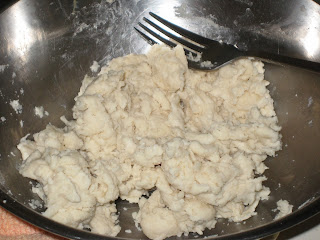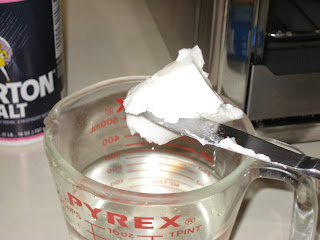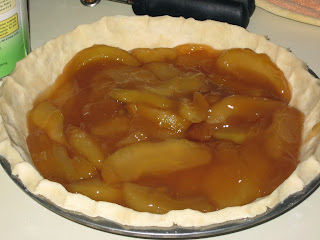 |
| Flaky Pastry I - for a single crust |
 |
| 1 1/4 c. flour...oh, it says sifted - oops, totally didn't see that instruction. |
 |
| 1/2 t. salt (for those who don't know, small "t" stands for teaspoon, while capital "T" stands for Tablespoon, and a Tablespoon equals 3 teaspoons. |
 |
| 1 1/3 cups ice water, huh? What's that for? |
I had shortening. Shortening, at least according to this can, contains both fully and partially hydrogenated palm oil among other things...I might be better off with lard! Be that as it may, I had this in the refrigerator, so it was chilled. Now, on to why I needed that 1 1/3 cups of ice water.
Usually, one would measure that 1/3 cup of shortening into a 1/3 cup measuring cup making sure to push out any air bubbles and then leveling off the top, and then scooping it out into the bowl and ending up with greasy stuff on the measuring cup, a spoon, a knife, or spatula or your fingers and your shirt and the counter and well, you get the picture. So, something I learned wayyyy back in high school home-ec class, yeah, Home-Ec, that's what it was called and I'd hate to hazard a guess what it's called today - does it even involve cooking from scratch? OK, before you tell me to get off the soap-box, I'll move on.
I needed 1/3 cup shortening. I had 1 1/3 cups of ice water in the measuring cup. Some simple math would tell me that to get 1/3 cup of shortening by this method, the water would have to be brought up to 1 2/3 c. so I started adding scoops of shortening from the can into the water. It really wasn't scoops because I kind of know how to reckon about what 1/3 c. is and only had to add little bits to actually get the water to come up to 1 2/3 cups.
And, here you have it. Notice that it is at a scant 1 2/3rds mark, that's because shortening floats like the icebergs that the Titanic hit, so you have to use your knife or spoon to gently push the shortening down a little which then raises the water level. You can then drain the water, or scoop out the shortening with a spoon letting the water drain off, and the shortening can be plopped into your bowl of flour and salt. I hope I didn't lose you on that process. You can also use this method for measuring other goopy things such as peanut butter or butter. Of course, if you find it easier to use a precise measuring cup, by all means do so, but this works for me. Another method would be to weigh the shortening on a paper towel or plate, but you'd have to know how much 1/3 cup of shortening weighs. Not all things weigh the same per measuring cup marker due to their density. Molasses & honey are heavier, cheese is lighter, something to consider when choosing alternate methods.
Back in February when we were still considering doing the kitchen remodel, I packed up all that I figured I wouldn't be using for whatever time it would take, and that included my pastry blender. When cooking at home as a young person, we never had a pastry blender, and I learned to accomplish the same goal using two knives held side-by-side. It takes a little bit to get it started at first, but overall still only took a few minutes and with the knives, it was easy to scrape any clinging shortening/flour mixture just by scraping the knives against each other. I find that a lot easier than the pastry blender with all of its blades.
 |
| Shortening all mixed into the flour mixture. |
And finally, the recipe calls for 1/4 cup ice water which is added 1 t. (remember, small t = teaspoon) at a time while mixing. It has been so very dry here, and likely too because I did not sift my flour I probably had a little more than the 1 1/4 cups called for, I had to use just a tad over the 1/4 cup of water to get the dough to the right consistency.
 |
| Mixed up dough - just perfect. |
All the while I was mixing this up, I was thinking that I'd probably have to either pat the crust out to the desired thickness, or pull a jar out of the cupboard to use because I knew my wooden rolling pins were all packed up as well. Since I only made enough dough for a single crust pie, I was also trying to remember if I'd pack up my pie pans, whether metal or glass. In checking that cupboard, I had not packed them, and lo and behold, there was my glass rolling pin. I received this one from my first mother-in-law decades ago (used) but we had one like it when I was growing up, but ours didn't have the end-cap. This one not only has the end cap, but somewhere along the line, I looked it up on the internet and printed out a sheet of paper for it and stuffed it inside. Do you know why this is glass and has an end cap? Why, to fill with ice cubes/ice water so that while rolling your dough, it doesn't get too warm and thus sticky. At least this is what I've been told. I've never put water or ice into it, thinking it would create condensation, and I wouldn't want extra water on my crust.
 |
| Patted out to about 8" before using rolling pin; on a sheet of waxed paper as I don't like cleaning gunk off my counter top. |
 |
| Crust in tin. |
This is the crust with one can of filling. Hmmm, looks a bit skimpy to me, and I know that crust will just burn. Well, maybe I could fold it over and make it a bit of a rustic tart-like 'pie'. NO! I want PIE! I've been wanting PIE for weeks!
 |
| Before baking. |
 |
| After baking |
The final product, and my assessment: the oven did fine, I will make pie in the oven again. I think next time, I may try the convection feature and see how that does. With this method, I would probably bake it just a little longer, maybe another five minutes. The crust and the bits on top were a bit light - I was afraid of them burning - and the bottom crust was not as dry and flaky as I'd hoped, being perhaps undercooked. How did the pie taste? Well, after the big scrumptiously rich meal of prime rib and baked potatoes, the pie wasn't as sweet as I'd expected. That was actually quite a nice result.
Did the flavors play well together? For me and Marty, neither of whom are picky eaters, it was interestingly good. I enjoyed it even more over the next few days after the flavors melded, and also with topping it with a little cherry/chocolate ice cream adding the extra sweetness. Next time, I will also try a different crust recipe since Marty really expected a "sweet" crust like one of the local restaurants has...according to him, but I've never noticed. In the above picture, after it cooled, the filling sank even lower from the crust, so maybe a third can would have been beneficial? But then, come to think of it, I didn't use the entire can of blueberry filling, keeping back maybe half a cup or so, thinking I was adding too much to the smaller pie pan.
I hope you enjoyed my lengthy adventure for my first pie in the toaster oven. I'm satisfied knowing it can be done and it can turn out well, despite my faux pas.








Pie in the toaster oven! Who'd've thunk it??! I'm so glad you're doing this -- my horizons will be sufficiently broadened!! :)
ReplyDelete